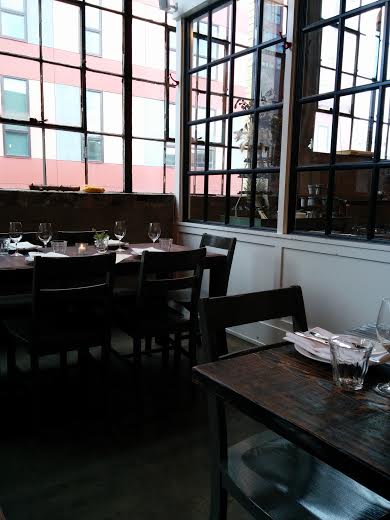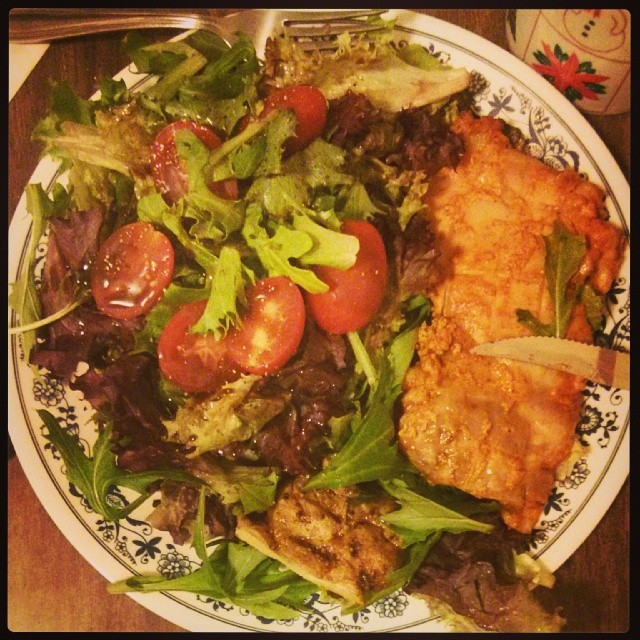Many moons ago, fellow FancyFrites’s blogger Janine and I had a chat about chef knives and how she doesn’t use the Chinese cleaver as she prefers the French styled chef’s knife whereas I was the counterpoint of that. I’m really not used to the French chef knife and that Chinese vegetable cleaver is the only knife I use to do anything. I find the blade geometry, weight and balance to be too different. It makes sense though due to how we were brought up and trained on how to cook.
Just to illustrate, I’m talking about this. A flat light thin dextrous blade that is used for everything from mincing, slicing, julienning to ‘grinding’ meat, filleting, pounding things, carving and even flattening dough wrappers. No chopping bones though, it ruins it. You use a heavier specialized cleaver for that.

I actually was a bit surprised she doesn’t use the cleaver as she is half Chinese and it is a kitchen staple from professional chefs to housewives in Chinese influenced households. More interesting to me was when she wondered whether it was easy or not to do intricate knife work. But that makes sense to me as well, since the western cleaver is heavy blade to hack bones and cleave meat so to speak. Western cleavers are most definitely not a tool for finesse. Needless to say, if one of my most food savvy friends who is quite familiar with the Chinese culture isn’t familiar with this cleaver, most of my non-Chinese friends wouldn’t be either.
Check out what Martin Yan does to a cucumber. But let’s be real here, he could do that with any sharp chef’s knife with his skill.
This is beginning to become a post about the Chinese cleaver, which isn’t the point of this post. It’s just a back story about how it got me browsing around kitchen knife preferences on the internet amongst the world of French chef knives and Japanese santoku’s. This led me to Fuschia Dunlop’s page, a blog article mentioning about her and cleavers, and then led me to an interview she did for BBC Radio on kitchen gadgets – her segment is on 8:05 – 13:05. I thought to myself, “This woman knows what’s up, I must investigate.”
Fuschia Dunlop’s story is an interesting one. It is about her going to pre-rapid-double-digit-growth China in the mid 1990’s studying as an exchange student from the UK. She ends up attending a prestigious culinary school in Sichuan to becoming a trained Chinese chef while being the first westerner to study there. From there on, it becomes the catalyst for her to spread the knowledge of Chinese food to the rest of the world.
This essentially is the trifecta of my own personal interests: a) food b) chinese culture c) travel.
Judging by the cover, I initially imagined that it was going to be a travel book that balks about how weird ‘real’ Chinese food is, from ‘century old eggs’ (represented in Fear Factor, but in reality, its a common appetizer and breakfast item in Asia), to dogs, to bugs, to shark fin… we just can’t get away from that. As a Chinese American/Canadian, I’m tired of that narrative. Tell me something I haven’t heard before! In Chop Suey: A Cultural History of Chinese Food in the United States, it documents some of America’s first contact in the ports of Canton in the 1800’s. Within those pages, it still mentioned similar items and 200 years later and that’s still all we hear in America. I personally think that’s incredible since aside from Panda Express, this is what America focuses on when it comes to Chinese food.
Shark’s Fin and Sichuan Pepper, A Sweet-Sour Memoir of Eating in China is fascinating in several aspects to me – authenticity and perspective. This could simply be a memoir about eating ‘strange’ things and just writing about it for shock value. Fortunately it is not. Fuschia in her time there transformed herself into a sinophile or maybe even an Egg, white on the outside, yellow on the inside. She immersed herself into a culture where I personally think if you’re not born into it, it is incredibly hard to understand. Nothing could be more apparent especially with culinary customs that runs contrary to the west – family style dinners, chopsticks, steamed meats, ‘food therapy’, superstitions surrounding food etc. Her open mindedness, adventurous spirit, and her three month tenure at the culinary academy set the stage for an incredibly insightful revealing read about Chinese cuisine at large.
Her commentary about cleaver usage mirrors exactly what I was taught growing up, which is what I continue to use in my day to day cooking from deboning chicken, cutting meat, to making paper thin slices of vegetables. Her recipes that she mentions is what I’m familiar with and dishes I ate being raised in a Chinese household. I especially liked how she mentions a lot about mouthfeel and texture too which constitutes a big part about balance when it comes to Chinese cuisine which is an element that western cooking does not emphasize much about. I actually have a hard time explaining this to my non Chinese friends at dim sum restaurants to my friends and especially when topics comes to typical Cantonese delicacies of shark fin, sea cucumbers, abalone and dried fish bladders. They’re not sought out for the flavour or taste – those items don’t really have much to begin with, but it is rather how it interacts with flavours and how it feels when you’re consuming the item.
It’s comforting and intriguing to me that somebody that is non-Chinese ‘gets it’ and is able to articulate it in an engaging succinct manner for those who are not familiar of why Chinese eat the things they eat. I found it to be refreshing to read her point of view as she’s adapting to China and how she contrasts her culinary experiences to that of her native UK.
She treks around China in various regions and explores the distinction between the food in different provinces. From muslim influenced Xinjiang of the old silk road featuring naan bread and lamb, to the north which is heavy in wheat and noodles and its famed peking duck, to Sichuan famed for spicy and ‘numb’ flavours to the Guangdong/Canton region reknown for the abundance of fresh ingredients and proximity to seasfood. “Chinese Food” in America has its origins in the Guangdong/Canton region.
There also a good dosage of Chinese history in its past, present and future. She explores how the imperial Chinese courts ate and how that influenced modern Chinese cuisine, how the Maoist Cultural Revolution tried to suppress and eradicate wasteful luxurious eating, how the Great Leap Forward led caused 30 million deaths and how the Chinese are dealing with post-Deng Xiao Ping economic reform wealth with a rapid changing customs starting to mirror western style diets of high meat high fat diets. She talks about pollution, local food movement in small pockets of china, the difficulties sustaining a population of 1 billion, the distrust of merchants selling food that might be laced with poison and hormones.
I really admired her adventurous spirit to find her truth in the Chinese culinary traditions. She goes from dispelling of Chinese food myths – live monkey brains, to eating scorpions and insects and submerging herself into controversial territory of eating endangered animals. It’s interesting to hear her articulate her thoughts about eating things for the sake of eating them, which I find myself thinking from time to time.
I later discovered that I’ve read an article named “Culture Shock” that she wrote a long time ago which I thought were very poignant thoughts from the other side of the ocean. She and some of China’s top chefs went to Yountville to visit The French Laundry. She remarked that they were at one of the world’s finest restaurants and a chef quipped “according to whom?” It goes to show we’re on both sides of the same coin. Everything is weird if we’re not exposed to it enough.
All in all, I cannot recommend it highly enough for anybody that is curious in the three areas I’ve mentioned before: Chinese culture, food, and travel. It packs a lot of information and written in a light and engaging tone. Do yourself a favour and pick a copy up and prepared to be really schooled on the essence of being Chinese, a nation that puts food first from carvings of pork and cabbage from jade, and love poems to food written by the most influential poets of ancient China. I trust it’ll shed some insight into why Chinese people are always taking photos of food and posting it on Instagram. I do like myself some good food porn.

People thought braised pork and cabbages were excellent subjects to carve jade out of back for royalty in Imperial China. Go check this out in the National Palace Museum in Taipei, it’s amazing in real life.




